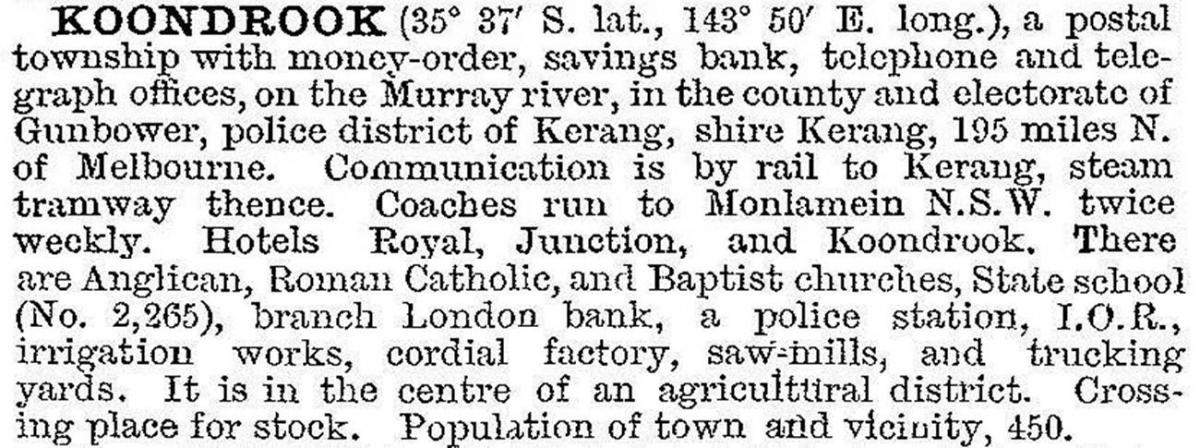Koondrook
Koondrook is a rural township on the Murray River, north of Bendigo and 23 km north-east of Kerang. It is closely linked to Barham, New South Wales, by the Barham-Koondrook Bridge (1904). Koondrook’s name is thought to be derived from an Aboriginal word meaning moon.
During the mid-1870s, when local pastoral runs were subdivided for farm selections, timber cutters began operations on Gunbower Island and in the Koondrook area. A landing site for Murray-River traffic was established west of the bridge in 1877-78. A flour mill was opened in 1878, drawing grain from both sides of the border and transporting flour by river boat. A punt (1884) assisted cross-river traffic. Koondrook township was surveyed during the late 1870s.
A school was opened in 1880, and a hotel in 1882. The Koondrook Irrigation Trust, one of four in the Kerang district, was established in 1885 or soon afterwards. In the mid-1880s Kerang was connected by railway to Bendigo (and hence Melbourne), and in 1889 a private tramway was opened, connecting Koondrook to Kerang. The transport network was completed when the bridge to Barham replace the punt in 1904. Built by Monash and Anderson, the bridge is heritage listed. Koondrook was described in 1903 in the Australian handbook:

Of the two towns, Barham is the larger, having facilities and amenities such as the Barham-Koondrook hospital, the secondary school, the harness-racing track and the golf course. Koondrook and Barham field a combined football team.
Koondrook has a riverside reserve, a caravan park, a motel, a recreation reserve, tennis courts, a swimming pool, a memorial hall, a general store, Uniting and Anglican churches and a primary school (48 pupils, 2014). The tramway, which was taken over by the Victorian Railways in 1952, closed in the early 1970s. The station complex is on the Victorian Heritage Register.
Koondrook is in the Torrumbarry Irrigation District, with extensive grazing and dairying holdings. A sawmill continues to handle local timber. Some new Koondrook wharf developments were proposed in 2012 to bring the once prominent riverboat town back to life.
Koondrook’s census populations have been:
| census date | population |
|---|---|
| 1901 | 339 |
| 1911 | 623 |
| 1933 | 735 |
| 1947 | 660 |
| 1954 | 757 |
| 1961 | 889 |
| 2011 | 769 |
Further Reading
A pictorial history of Barham-Koondrook District, 1843-1993, Barham Historical Research Group, c1993
The Barham-Koondrook bridge 1904-2004: a centenary history, 2004


